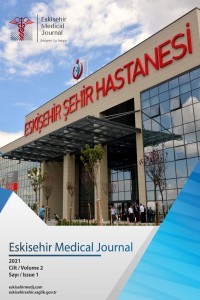Lomber disk hernisi olan hastalarda intradiskal perkütan radyoopak jel etanol enjeksiyonunun ağrı üzerine etkisi: Klinik deneyimimiz
lomber disk hernisi, perkütan intradiskal enjeksiyon, radyoopak jel etanol, görsel analog skor
The effect of intradiscal injection of percutaneous radiopaque gel ethanol on pain in patients with lumbar disc herniation: Our clinical experience.
Lumbar disc herniation, Percutaneous intradiscal injection, Radiopaque gel ethanol, Visuel analog scale,
___
- Barrero LH, Hsu YH, Terwedow H: Prevalence and physical determinants of low back pain in a rural Chinese population. Spine 31: 2728-2734, 2006
- 2) Bellini M, Romano DG, Leonini S, Grazzini I, Tabano C, Ferrara M, Piu P, Monti L: A Cerase 2 Percutaneous injection of radiopaque gelified ethanol for the treatment of lumbar and cervical intervertebral disk herniations: experience and clinical outcome in 80 patients. AJNR Am J Neuroradiol 36: 600-605, 2015
- 3) Borenstein DG: Chronic low back pain. Rheum Dis Clin North Am 22: 439-456, 1996
- 4) Galluzzi KE: Management of neuropathic pain. J Am Osteopath Assoc 105: 119, 2005
- 5) Gautam S, Rastogi V, Jain A, Singh AP: Comparative evaluation of oxygen-ozone therapy and combined use of oxygen-ozone therapy with percutaneous intradiscal radiofrequency thermocoagulation for the treatment of lumbar disc herniation. Pain Practice 11: 160-166, 2011
- 6) Gazzeri R, Galarza M, Neroni M, Esposito S, Alfieri A: Fulminating septicemia secondary to oxygen-ozone therapy for lumbar disc herniation: case report. Spine 32: 121–123, 2007
- 7) Gibson JN, Waddell G: Surgery for degenerative lumbar spondylosis: updated cochrane review. Spine 30: 2312–2320, 2005
- 8) Ginanneschi F, Cervelli C, Milani P, Rossi A: Ventral and dorsal root injury after oxygen-ozone therapy for lumbar disk herniation. Surg Neurol 66: 619-621, 2006
- 9) Goupille P, Mulleman D, Mammou S, Griffoul I, Valat JP: Percutaneous laser disc decompression for the treatment of lumbar disc herniation: a review. Semin Arthritis Rheum 37: 20–30, 2007
- 10) Han HJ, Kim JY, Jang HY, Lee B, Yoon JH, Jang SK, Choi SH, Jeong SW: Fluoroscopic- guided intradiscal oxygen-ozone injection therapy for thoracolumbar intervertebral disc herniations in dogs. In Vivo 21: 609–613, 2007
- 11) Heron J, Guimaraens L, Casasco A, Sola T, Cuellar H, Courtheoux P: Percutaneous treatment of lumbar intervertebral disk hernias with radiopaque gelified ethanol: a preliminary study. J Spinal Disord Tech 20: 526-532, 2007
- 12) Kawaguchi Y, Matsui H, Gejo R, Tsuji H: Preventive measures of back muscle injury after posterior lumbar spine surgery in rats. Spine 23: 2282–2287, 1998
- 13) Legrand E, Bouvard B, Audran M, Fournier D, Valat JP: Sciatica from disk herniation: medical treatment or surgery? Joint Bone Spine 74: 530–535, 2007
- 14) Lo Giudice G, Valdi F, Gismondi M, Prosdocimo G, de Belvis V: Acute bilateral vitreo-retinal hemorrhages following oxygen-ozone therapy for lumbar disk herniation. Am J Ophthalmol 138:175-177, 2004
- 15) Luijsterburg PA, Verhagen AP, Ostelo RW, van Os TA, Peul WC, Koes BW: Effectiveness of conservative treatments for the lumbosacral radicular syndrome: a systematic review. Eur Spine J 16: 881–899, 2007
- 16) Martin DJ, Rad AE, Kallmes DF: Prevalence of extravertebral cement leakage after vertebroplasty: procedural documentation versus CT detection. Acta Radiol 53: 569–572, 2012
- 17) Muralikuttan KP, Hamilton A, Kernohan WG, Mollan RA, Adair IV: A prospective randomized trial of chemonucleolysis and conventional disc surgery in single level lumbar disc herniation. Spine 17: 381–387, 1992
- 18) Oláh M, Molnár L, Dobai J, Oláh C, Fehér J, Bender T: Evaluation of the efficacy of conservative therapies with clinical parameters and magnetic resonance ımaging in lumbar disc herniations. Rheumatol Int 28: 749-756, 2008
- 29) Oliphant D: Safety of spinal manipulation in the treatment of lumbar disk herniations: A systematic review and risk assessment. J Manipulative Physiol Therap 27: 197-209, 2004
- 20) Riquelme C, Musacchio M, Mont’Alverne F, Tournade A: Chemonucleolysis of lumbar disc herniation with ethanol. J Neuroradiol 28: 219–229, 2001
- 21) Sharps LS, Isaac Z: Percutaneous disc decompression using nucleoplasty. Pain Physician 5: 121-126, 2002
- 22) Sinan T, Sheikh M, Buric J, Dashti K, Al-Mukhaimi A: Percutaneous coblation nucleoplasty in patients with contained lumbar disc prolapse: 1 year follow-up in a prospective case series. Acta Neurochir Suppl 108: 107-112, 2011
- 23) Theron J, Cuellar H, Sola T, Guimaraens L, Casasco A, Courtheoux P: Percutaneous treatment of cervical disk hernias using gelified ethanol. AJNR Am J Neuroradiol 31: 1454-1456, 2010
- 24) Theron J, Guimaraens L, Casasco A, Sola T, Cuellar H, Courtheoux P: Percutaneous treatment of lumbar intervertebral disk hernias with radiopaque gelified ethanol: a preliminary study. J Spinal Disord Tech 20: 526–532, 2007
- 25) Weber BR, Grob D, Dvorak J, Muntener M: Posterior surgical approach to the lumbar spine and its effect on the multifidus muscle. Spine 22: 1765–1772, 1997
- 26) Zhu H, Zhou XZ, Cheng MH, Shen YX, Dong QR: The efficacy of coblation nucleoplasty for protrusion of lumbar intervertebral disc at a two-year follow-up. Int Orthop 35: 1677-1682, 2011
- ISSN: 2718-0948
- Yayın Aralığı: Yılda 3 Sayı
- Başlangıç: 2020
- Yayıncı: Eskişehir Şehir Hastanesi
Covid-19 Hastalarında D-dimer ve Eritrosit Dağılım Genişliği Arasındaki İlişkinin Klinik Önemi
Fragmente QRS'nin Varlığı Hemodiyaliz Hastalarında Ventriküler Aritmi ile İlişkili Olabilir
Fatih KARDAŞ, Gökay TAYLAN, Çağlar KAYA, İlhan KURULTAK
Özlem ÖZKALE YAVUZ, Koray HEKİMOGLU, Mehmet COSKUN, Gaye ULUBAY, M. Şule AKÇAY, Alev DOLU, A. Muhtesem AGILDERE
Berrin YALINBAŞ KAYA, Yonca YILMAZ ÜRÜN, İsmail YENİLMEZ, Yeliz MERT KANTAR, Ali TÜREYEN, Hatice HAMARAT, Zeynep IRMAK KAYA, Serdar EFE, Cansu DEMİRAL, Pamir ÇERÇİ, Muslih ÜRÜN
Çok Nadir Birliktelik: Fundus Divertikülü Ve İnce Bağırsak Adenokarsinomu
Nadir Bir Koroner Arter Çıkış Anomalisi: İkiz Circumflex Arter
Cihan ÖZTÜRK, Melik DEMİR, Burcu ÇAKIR, Kenan YALTA
COVID-19 Pandemisi Sırasında Acil Genel Cerrahi İhtiyacı Olan Hastaların Retrospektif Analizi
Gürkan ALTUNTAŞ, Murat Mümin YAZICI, Özlem BİLİR, Gökhan DEMİRAL, Gülcan Nur YILMAZ
Vücut Yağ Oranının Kemoterapiye Bağlı Bulantı-Kusma Üzerine Etkisi
Fatih SARGIN, İsmail BEYPINAR, Hasan Şenol COŞKUN
Mine TEPETAŞ, Alaettin ÜNSAL, Ahmet AY, Sevda SUNGUR, Didem ARSLANTAŞ, Halime KÜÇÜK
Is there a covid-19 transmission with percutaneous needle prick? A case report
